Effectiveness of treatmentback painit depends directly on how exactly it was shippeddiagnosis. . . However, pain syndrome itself is not a characteristic symptom - it is a common symptom that makes it impossible to determine the cause of the disease. It can be caused by many different pathologiesback pain, and not all of them are associated with musculoskeletal disorders.
In self-medication, patients mistakenly believe that coping with pain is paramount, and they lose sight of the fact that every pain has a cause. Taking painkillers is a symptomatic treatment that does not affect either the outcome of the disease or the cause of the pain.
The main causes of back pain
Consider the maindiseasecausingback pain. . . To facilitate diagnosis, doctors divide the back into upper (cervical spine), middle (chest spine), and lower (lumbosacral) parts.
Upper back pain

Cervical spine pain requires the most attention. The reason is to be found in the unique anatomical features of the cervical vertebrae: the artery vertebrae pass through them and supply one-third of the brain with blood; the first and second cervical vertebrae form a movable complex articulation with the skull responsible for rotating and tilting the head; any disease at this level can cause severe neurological damage, as injury or even mild compression of the spinal cord in the cervical spine immediately leads to impairment of motor and / or sensory functions in the rest of the body.
Osteochondrosis of the cervical spine
Normally, intervertebral discs, joints, ligaments, and tendons have no strength of their own, and their blood supply depends on how intensely the nearby muscles and bones are supplied with blood. If this process is disrupted, for example, in a sedentary and sedentary office worker, degenerative-dystrophic lesions begin in them. The nutrition of the cartilage of the intervertebral discs and joints is impaired, the ligaments and tendons become thicker, the spinal canal narrows due to sclerotic lesions, and the distance between the vertebrae decreases.
Among non-professionals, this disease is called spinal osteochondrosis. Although degenerative-dystrophic processes are common throughout the spine, osteochondrosis is the most common cause of cervical spine pain. In addition, as in other parts of the spine, this disease can be complicated by an intervertebral hernia. However, due to the peculiarities of the anatomy of the cervical spine, even a small hernia can cause serious complications.
Injury
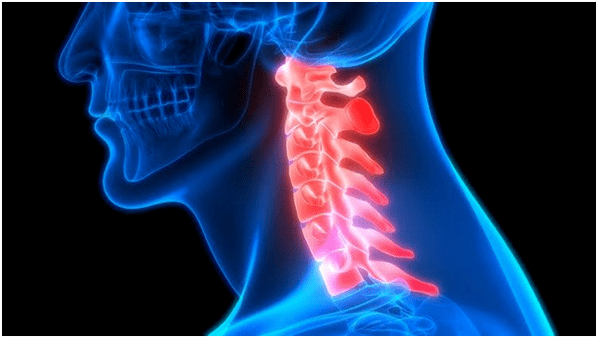
Although spinal cord injury is more commonly diagnosed in the lumbar spine, nearly 50% of spinal cord injuries occur with trauma to the cervical spine. This is due to the peculiarities of the anatomy of the neck: the lack of an advanced musculoskeletal system and massive vertebral bodies, the high mobility also contributes to the trauma without direct physical impact (e. g. , sudden stopping or backstroke). accident, a so-called whiplash neck injury caused by a sharp bending and then a sharp extension of the cervical spine) often occurs). Pain is a constant companion to any spinal cord injury.
Myositis
Myositis or inflammatory muscle diseases are a whole group of diseases characterized by muscle pain. The most common cause of banal myositis is forced labor during any work, hypothermia, drafts. Muscle pain is the result of osteochondrosis, an intervertebral hernia in the cervical spine - the muscles take over much of the load on the neck, ultimately leading to overload, muscle cramps, impaired microcirculation and inflammation.
Neuralgia
Neuralgia is a condition in which the nerve fibers themselves become a source of constant pain impulses. The pain is paroxysmal and can be intensified and provoked by turning and tilting the head in cold weather. The cause of neuralgia is related to diseases of the spine - osteochondrosis, intervertebral hernia, scoliosis, etc. The direct cause of pain is irritation of the roots of the spinal cord as they become pinched in the intervertebral space, a muscle spasm that disrupts metabolism in the nerves passing through the spasmodic muscles. Unlike neuritis or neuritis, neuralgia pain is intermittent, with no abnormalities in the nerve fibers themselves.
Heart disease
Heart diseases such as angina pectoris, ischemic heart disease, coronary atherosclerosis are often accompanied by pain radiating to the neck, lower jaw, shoulder, and left forearm. The pain may be accompanied by numbness, tingling of the skin, which simulates pain in osteochondrosis of the cervical spine with an intervertebral hernia. Patients often receive massage, physiotherapy, and other doctors, although an electrocardiogram is enough to diagnose the cause.
A characteristic feature of such pain is that antianginal drugs that improve blood flow through the coronary arteries (isoket, nitroglycerin) relieve pain within a few minutes.
Pain in the middle of the back
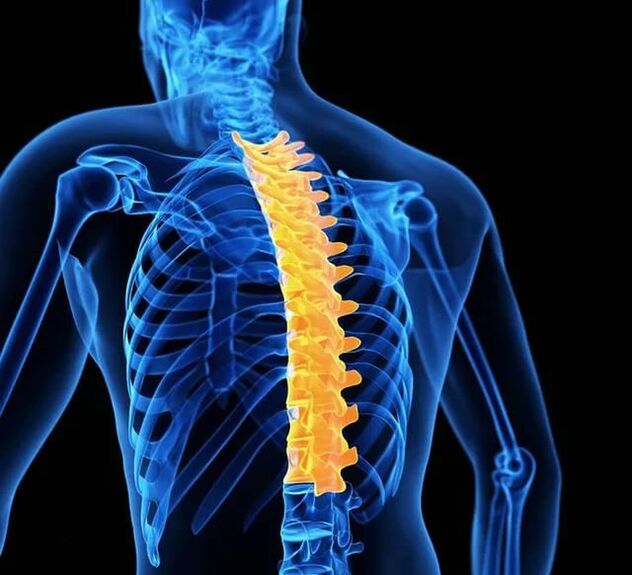
The thoracic spine consists of 12 thoracic vertebrae, each of which is joined by a pair of ribs. Together they provide protection for the chest organs. The size of the thoracic vertebrae gradually increases, from 1 the thoracic vertebrae to the beginning of the lumbar spine - this can be explained by a gradual increase in the load on them. The mobility of the middle part of the back is significantly less than the mobility of the neck, the ribs provide additional protection, so traumatic damage to the spinal cord is less common.
Spine curvature or scoliosis
Scoliosis or scoliosis is a pathological curvature of the spine that occurs in several planes. The causes of scoliosis are still unknown, and the disease begins in childhood. They contribute to a lack of physical activity, back muscle weakness, poor posture, and the organization of schoolchildren’s workplaces. The pronounced curvature, the distribution of loads and the biomechanics of the spine, the overload of the muscles compensating for part of the load,arisechronicback pain.
Arthritis (spondyloarthritis)
The intervertebral joints, together with the intervertebral discs, unite the spine into a whole. Each vertebrae has 4 joint surfaces that form an articulation with adjacent vertebrae. Like all other joints, the intervertebral joints can become inflamed. This condition is called spondyloarthritis. There are two main causes of inflammation of the intervertebral joints. These are systemic rheumatic diseases (such as rheumatoid arthritis or ankylosing spondylitis) or reactive inflammation that results from increased load in osteochondrosis, scoliosis, and other pathologies of the spine. Inflamed joints lose their function: stiffness of movement, stiffness of the spine, prolonged back pain.
Diseases of the gastrointestinal tract and back pain
Diseases of the abdominal organs often cause recurrent back and spine pain. There is also a direct link between pathologies of the gastrointestinal tract and diseases of the musculoskeletal system. Diseases such as chronic colitis or gastroenteritis are the background of spondyloarthritis or osteochondrosis of the spine.
The most common pain-related back pain is gastric ulcer and duodenal ulcer, hiatus hernia, acute or chronic inflammation of the pancreas. This phenomenon is due to the peculiarities of the sympathetic and parasympathetic systems, whose nerve fibers are present in all organs of the abdominal cavity. Some of the pain impulses they perceive return to the roots of the spinal cord, simulating spinal and back pain.
Kidney disease and back pain
The kidneys are a paired organ located in the retroperitoneal space that, like the abdominal organs, is tightly connected to the roots of the spinal cord by nerves. In the presence of inflammation, stones, or other urinary tract pathologies, some of the pain impulses reach the spinal cord, which simulates spinal disease.Symptoms of back painmay occur in acute pyelonephritis, renal colic, renal abscesses. A characteristic symptom is tension in the back muscles in the kidney projection, which occurs due to inflammation of the kidneys or the tissue surrounding them.
Pain in the lumbosacral spine
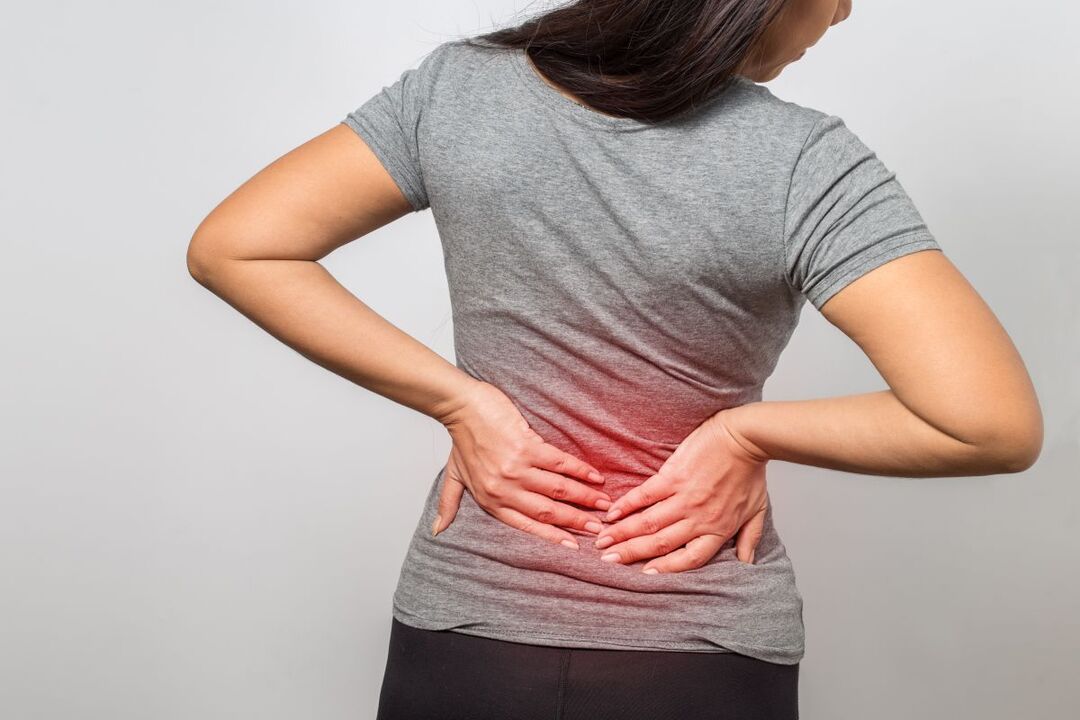
The lumbosacral spine has the greatest strain. Up to 60-70% of the adult population in developed countries complain of back pain. This is a favorite localization of intervertebral hernias. One patient is most often diagnosed with 2-3 hernias in the lumbosacral spine. In addition, lower back and sacral pain are often associated with gynecological and urological pathologies.
Intervertebral hernia
Intervertebral hernia is the result of long-term osteochondrosis of the spine. While in the cervical region there is a relatively small load on the intervertebral discs, in the lumbosacral region all the discs exert enormous pressure. The healthy disc can compensate for any weight, thanks to the semi-liquid core, which acts as a hydraulic shock absorber. However, due to osteochondrosis, the fibrous and strong cartilage (anulus fibrosus) running on the periphery of the intervertebral disc loses its elasticity and strength, and some parts may rupture. With a steep increase in load, such as lifting weights, the pressure inside the patient's cartilage increases, allowing its contents to actually "pass" through the damaged cartilage and fall into the lumen of the spinal canal, creating an intervertebral hernia.
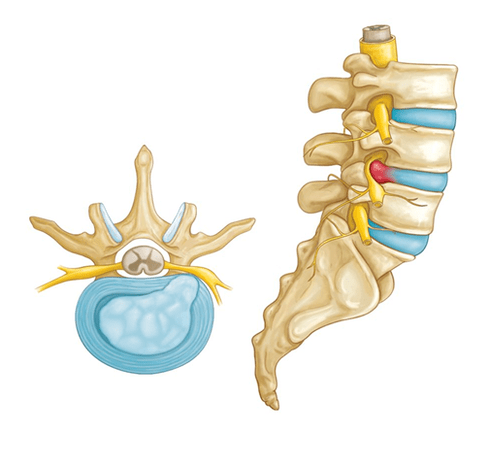
Seed fragments dropped from the disc compress the spinal cord and spinal roots. As a result, nerve tissue swells and blood circulation is damaged, accompanied by severe pain and protective muscle cramps. The pain can be unbearable, all the way to the use of narcotic painkillers. A characteristic feature is the irradiation of pain in the lower extremities. Sensitivity to pain, tingling and numbness of the skin of the legs and thighs may be reduced.
Intervertebral disc protrusion
The main difference between the protrusion of the intervertebral disc and the hernia is the preservation of the integrity of the annulus fibrosus. The cause of the pain is compression of the spinal cord and its roots through protrusion at the periphery of the intervertebral disc. However, if the process continues, the protrusion can easily become a hernia. The symptoms and pain are similar to those of a disc herniation, as the severity of the pain syndrome depends not only on the size of the protrusion or hernia, but also on its location.
Spondylosis of the spine
Excessive spinal strain and degenerative-dystrophic processes can lead to ossification of cartilage tissue, which is saturated with calcium salts and develops into sharp coracoid bone outgrowths or growths in the periphery of vertebral bodies. As the process progresses, these outgrowths can merge with the same growths on the body of adjacent vertebrae. Over time, all the vertebrae grow together, the spine losing its elasticity and flexibility. Pain occurs due to irritation of the spinal cord and its roots, reactive inflammation, and dystrophy of the soft tissues, ligaments, and muscles surrounding the spine.
Radiculitis
Radiculitis is called intense pain that results from circulatory disorders and ischemia of the roots of the spinal cord, which are strangled by a hernia or protrusion associated with osteochondrosis of the spine. Various skin sensitivity disorders are possible in the buttocks, perineum, thighs and lower legs. Initiated sciatica leads to muscle wasting and weakness. Typical symptoms are pain along the sciatic nerve, exacerbated by movement, weight lifting, and cold weather. This condition is called sciatica or sciatica.
Spine infection
The vertebrae are made up of spongy bone tissue rich in bone marrow. When the infection enters the bloodstream in the body of the vertebrae, an inflammatory process can occur - osteomyelitis. The gradual breakdown of bone tissue is accompanied by necrosis - a picture that is also characteristic of spinal tuberculosis. Pain can occur due to both irritation of the nerve endings and abnormal compression fracture of the spine, which is weakened by inflammation.
Gynecological and urological diseases
Diseases such as cervical cancer, endometriosis or adnexitis (inflammation of the uterine appendix) in women, prostatitis or prostate cancer in men are often accompanied by severe pain in the lumbosacral spine. The nature of the pain is explained by the irritation of the nerves caught in the area of inflammation or the growth of nerve strains by the tumor.
The back muscles hurt along the spine
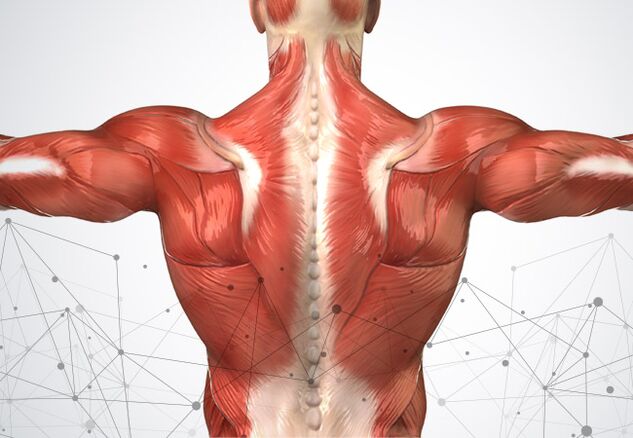
Well-developed back muscles are a sign of a healthy spine, as the muscle splint relieves some of the stress and also stabilizes the spine. In chronic diseases of the spine, muscles are exposed to overload, which weak and atrophied muscles cannot withstand. As a result, muscle cramps occur and due to muscle metabolism disorders and pain. This condition is called myofascial syndrome, which is characterized by osteochondrosis of the spine, hernias, and protrusions in the intervertebral discs.
Postoperative pain
Spinal surgeries are usually accompanied by extensive trauma - to stabilize and restore the integrity of the vertebrae, doctors can resort to fitting metal structures, tightening screws and removing non-viable tissue. The pain in this case is due not only to the disease itself but also to the surgery. With proper rehabilitation and postoperative care, the pain will gradually disappear. However, if you disregard the instructions of doctors and ignore mandatory practices in the postoperative period, the pain can become chronic.
How are the causes of back pain diagnosed?
In order to diagnose back and spine pain, seek medical help in a timely manner from a qualified neurologist. In the first stage, neurological examination, patient assessment, reflexes and symptoms are performed. An experienced and knowledgeable physician is well aware of the causes of back and spine pain for certain causes and characteristics.
Back pain for no apparent reason should be especially vigilant. This can occur with recurrent pain in other organs and systems, tumors, and diseases of the spinal cord.

To find out why the back and spine hurt, a neuropathologist may prescribe magnetic resonance imaging. This is the most effective and safest way to diagnose almost every possible cause of back pain. The procedure is based on the ability of magnetic fields and radio waves to give a clear and detailed image of the spine and spinal cord without the use of X-rays and other harmful factors.
How to relieve spinal pain
To relieve but not treat back pain, take a painkiller that lasts for several days, for which you should wait for a specialist consultation. Most commonly, non-steroidal anti-inflammatory drugs or NSAIDs are used for this purpose. However, it is important to note that this group of medicines can cause dangerous side effects, the likelihood of which increases with long-term use. That is why it is important not to postpone the medical visit and examination. treatmentdiseasesspineand causesback pain.
Treatment of spinal pain
As stated at the outset, the effectiveness of treating back pain depends on the accuracy of the diagnosis. Despite the obvious, many patients "cure" the pain for years, but not the disease itself, they always postpone a visit to the doctor, they turn to traditional healers, chiropractors and chiropractors. In addition, such procedures are not only contraindicated but also dangerous for some diseases of the spine.
There are effective and scientifically proven treatments for a variety of ailmentsspeciescausing diseasesback pain. . . Many of these require the patient to persevere and persevere in the fight against the disease. It’s important to note that there are no pills or injections that can cure osteochondrosis - only you can do this with a hard workout and physical exercise as shown by a neurologist.
Which doctor should I go for my spine pain?
Back pain is one of the most common neurological symptoms that occurs due to the involvement of the nerves and spinal cord in the pathological process. Therefore, the first specialist to need a consultation for spinal pain will be a neurologist. You may need to see another doctor based on the results of the test and magnetic resonance imaging. If the back pain is caused by heart disease, the patient is referred to a cardiologist, if the problem is in the digestive system, to a gastroenterologist. But most often, pain syndrome is precisely related to spinal pathology.


















































